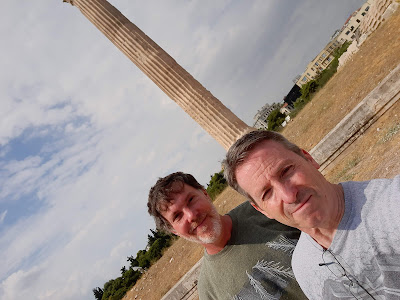In today's blog, we continue our walking tour through Athens, Greece and take you to the remnants of the Temple of Zeus. If you don't know your Greek Mythology, you'll learn who Zeus is, too. There was also some energy around the ancient site. You'll learn about all of those things and some architecture in today's blog.
WHO IS ZEUS? Zeus is the god of the sky in ancient Greek mythology. As the chief Greek deity, Zeus is considered the ruler, protector, and father of all gods and humans. Zeus is often depicted as an older man with a beard and is represented by symbols such as the lightning bolt and the eagle. Click for More about Zeus.
(Image; Zeus. Credit: https://curiousport.com/how-zeus-became-the-supreme-god-of-greek-mythology/)WHAT IS THE TEMPLE OF ZEUS? The Temple of Olympian Zeus, also known as the Olympieion or Columns of the Olympian Zeus, is a former colossal temple at the center of the Greek capital Athens. It was dedicated to Zeus, head of the Olympian gods. It was probably constructed at around 470 B.C when the ancient Olympic Games were at their peak.
WE WERE STRUCK BY THE HAND-CARVED DETAIL - Tom said: Look at the detail in this column capital, all carved by hand without templates. Note the scrolls are not perfectly symmetrical!
HOW IT CAME TO BE - According to Greeka.com, there is an interesting story behind the construction of this temple. In 470 B.C, there was a war between Elis and Pisa, two neighboring powers in the area of Olympia. Finally, Elean was defeated and as a penalty, the town gave the funds for building a magnificent temple right outside the stadium of Olympia.
ABOUT ITS CONSTRUCTION, NEVER COMPLETED - The Temple was never completed, and ironically, restorative architects were working on it when we visited because the majority of the Temple was covered in scaffolding!
As for the structure, it is hexastyle building. The entire monument was made of limestone and is covered with stucco. Parian marble was used for making the sculptures inside the temple and Pentelic marble was used to construct the roof tiles. The temple has thirteen columns on both sides and six columns each at two ends. The construction of the temple was never entirely complete. It went under renovation many times. The floor was initially made of colorful mosaics with pebbles and stones and later enveloped by marble.
The sculptures on the pediment and the metopes depicted the 12 labors of Hercules (click to learn about them) . Three different stories were sculpted on the east pediment, the west pediment, and the metopes (In classical architecture, a metope (μετόπη) is a rectangular architectural element that fills the space between two triglyphs in a Doric frieze, which is a decorative band of alternating triglyphs and metopes (see diagram below).
A BIT OF ARCHITECTURE- WHAT IS A DORIC FRIEZE?- It's a structural element that helps support the weight of the roof. Sitting just on top of that is the frieze, a horizontal section with a less structural and more decorative function. Above the frieze is the cornice.WHAT IS A CORNICE? - In architecture, a cornice is generally any horizontal decorative moulding that crowns a building or furniture element—for example, the cornice over a door or window, around the top edge of a pedestal, or along the top of an interior wall.
WHAT DOES IT LOOK LIKE NOW? The Temple of Olympian Zeus was badly damaged during the sack of Athens by the Heruli in 267 AD. Today, the ruined Temple of Zeus stands in the archaeological site of Olympia. We were surprised that there is quite a large area (of dirt) surrounding it, indicating that there was a large border around the area. We did see some scattered rectangular stones about 200-300 feet from the actual temple ruins.
 (Photo: View of the area around the Temple of Zeus- it was really a huge area)
(Photo: View of the area around the Temple of Zeus- it was really a huge area)
ENERGY AROUND - We sensed a lot of residual energy (that's leftover energy generated by a lot of emotions, that gets imprinted into an area, including the ground). In this case, it was likely because this was a temple of worship to Zeus. We also heard what sounded like soft chanting.

NEXT: A Look at the Historic Nix Hill







No comments:
Post a Comment